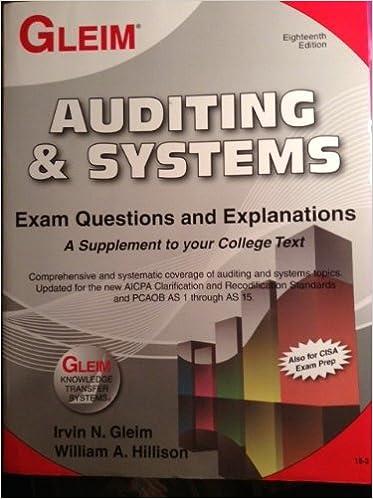Question
53. Mary Milken is the CFO of the Rbeck Company in Miami, Florida. The company is a closely held custom yacht builder with about 200
53. Mary Milken is the CFO of the Rbeck Company in Miami, Florida. The company is a closely held custom yacht builder with about 200 technical workers (engineers, marine architects, mechanics, boat workers, and so on), and 12 employees in its main office staff. Her primary job is to prepare the financial statements with the assistance of two full-time accountants. She normally follows generally accepted accounting principles, but she sometimes ignores them when she thinks they do not lead to what she considers best practices for the small number of her companys shareholders. In the previous decade, the company was owned by three sisters, each of whom served on the board of directors. One of the three, Vanessa Rbeck, served as the CEO during that period. The other two have always deferred to her with respect to her operational management decisions. Only a month ago, however, Vanessas sisters were killed when their private plane crashed en route to the Bahamas, which they frequently visited on weekends for relax-ation. Upon their death, all of their shares in the Rbeck company transferred to a single trustee in one of the large South Florida banks. Each sister had held her shares in revo-cable living trusts with the same bank named as successor trustee. As soon as the funerals were over, Mary and Vanessa met with the trustee, Annie Crusher. The meeting did not go well. Annie had grown up working in a family-owned retail boat business, and she thought her knowledge of the industry transferred to the yacht-building business. She began asking Vanessa a rapid succession of unfriendly questions in an adversarial tone of voice. Her questions strongly implied that a yacht-building business did not belong in South Florida but offshore where labor is cheaper. After the meeting, both Mary and Vanessa became afraid that Annie would do some-thing crazy like fire them both or liquidate the business. For the previous five years, Rbecks stock had sold for a steady $12 per share, with$8 per share in dividends. Vanessa received a good salary, but she depended on the dividends to send her children to private schools and to pay the large mortgage on her waterfront home in South Beach. She immediately realized that she was now at Annies mercy; she could easily cut off Vanessas dividends, lower her salary, or put her out of work. To make things worse, Mary was almost finished with the most recent annual report, and it appeared that earnings were down for the first time ever. Her preliminary calcu-lations showed earnings per share somewhere near $8. The problem with earnings had been caused by large bad debts from three clients who had been arrested for drug trafficking. Rbeck had entirely financed luxury yachts for the three clients because of their excellent credit history and prominence in the busi-ness community. However, the federal government seized all of the clients assets, leaving nothing for Rbeck but the three half-built yachts. After thinking things over, Vanessa asked Mary to find a way to avoid having to report lower earnings because of her concern as to how Annie might respond to the decline in earnings. Mary considered various options: Increase the estimated percentage of completion on all yachts in work-in-process inven-tory by 15 percent. This would wipe out most of the loss. Work in process estimates have always been very conservative anyway. Recognize revenue on the three yachts in default. It would be very difficult to sell them at a good price, but she could always argue that they could be sold if she could 438 Part III Occupational and Organizational Fraudkeep a straight face. The best strategy would be to find new buyers for them, but that could take a couple of years. Switch to mark-to-market accounting for some of the yachts in progress so the com-pany could recognize all of the profit when contracts with other clients are signed.
a. Is any option that Mary is considering acceptable under generally accepted account-ing principles? Why or why not?
b. Do any of the options being considered by Mary constitute financial statements fraud?
c. How would you handle the entire situation if you were in Marys shoes?
Step by Step Solution
There are 3 Steps involved in it
Step: 1

Get Instant Access to Expert-Tailored Solutions
See step-by-step solutions with expert insights and AI powered tools for academic success
Step: 2

Step: 3

Ace Your Homework with AI
Get the answers you need in no time with our AI-driven, step-by-step assistance
Get Started


